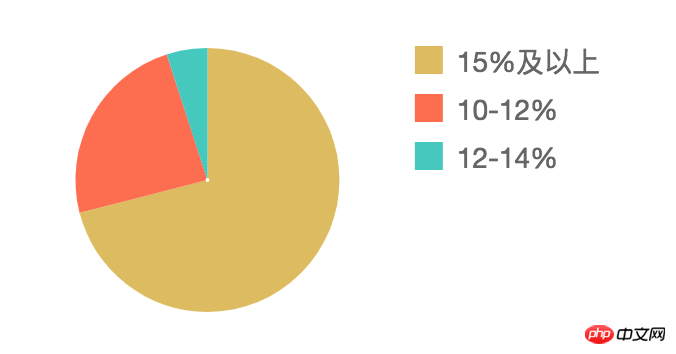这次给大家带来Chart.js轻量级图表库使用案例解析,Chart.js轻量级图表库使用的注意事项有哪些,下面就是实战案例,一起来看一下。
前言
最近项目中遇到一个在页面中画图表的需求,需要一个扇状图和一个柱状图,虽然能使用svg或canvas绘制,但吃力还不一定讨好,所以研究接入了主流的第三方图表库供项目使用。下面主要记录我使用过程中的一些体验和解决方法,具体教程请移步官方文档。
技术选型
研究了Highcharts、百度的ECharts、阿里的G2和Charts.js四个图表库,由于项目对图表需求不大,图表不复杂,所以引入了轻量级的Charts.js。Chart.js很容易上手,只需要在页面中引用脚本文件,并创建
GitHub源码: https://github.com/nnnick/Chart.js
Chart.js文档:http://www.bootcss.com/p/chart.js/
引入
GitHUb上下载源码,把里面的dist/Chart.bundle.js文件引入项目即可使用;查看源码,发现其兼容了多种模块加载方式,所以我使用requireJs在页面中加载。
使用经验
①图表颜色值个数可以不与数据个数相等,如
var pieConfig = {
type: 'pie',
data: {
datasets: [{
data: [10, 20],
backgroundColor: ['#debd5a', '#ff6d4a', '#3cc9bf', '#7599e9',]
}]
}
}②可以取消响应式options: {responsive: false},方便控制图表的大小,canvas多大图表便多大,canvas不会自动占满外层容器。
③取消legend的点击事件,因为点击legend会默认隐藏该数据的占比,所以我需要去掉点击事件,设置legend: {onClick: function () {}},修改点击事件。
④把legend由默认的矩形修改成正方形,设置legend的字体大小和色值
options: {
legend: {
position: 'right',
labels: {
boxWidth: 14,// 修改宽度
fontSize: 14,
fontColor: '#666666'
}
}效果如下

⑤柱状图去掉网格线,设置轴线颜色、矩形的宽度和y轴数据从0开始展示。由于使用的Chart.js 2.0,配置参数变化很多,所以网上很多列子已失效,这里给出有效的配置代码
options: {
scales: {
xAxes: [{
gridLines: {
color: 'rgba(0, 0, 0, 0)',// 隐藏x轴方向轴线
zeroLineColor: '#666666'// 设置轴颜色
},
barPercentage: 0.2,// 设置柱宽度
ticks: {// 设置轴文字字号和色值
fontSize: 12,
fontColor: '#666666'
}
}],
yAxes: [{
gridLines: {
color: 'rgba(0, 0, 0, 0)',// 隐藏要y轴轴线
zeroLineColor: '#666666'
},
ticks: {
fontSize: 12,
beginAtZero: true,// y轴数据从0开始展示
fontColor: '#666666'
}
}]
}
}效果如下

⑥给图表tooltips的数据加上单位,可以使用tooltips的callback函数设置
tooltips: {
callbacks: {
label: function (tooltipItem, data) {
var value = data.datasets[tooltipItem.datasetIndex].data[tooltipItem.index] + '%';
var title = data.labels[tooltipItem.index] + ':';
return title + value;
}
}
}效果如下

tooltips: {
callbacks: {
label: function (tooptipItem) {
return tooptipItem.yLabel + '个' ;
}
}
}效果如下

相信看了本文案例你已经掌握了方法,更多精彩请关注php中文网其它相关文章!
推荐阅读:
以上就是Chart.js轻量级图表库使用案例解析的详细内容,更多请关注php中文网其它相关文章!

每个人都需要一台速度更快、更稳定的 PC。随着时间的推移,垃圾文件、旧注册表数据和不必要的后台进程会占用资源并降低性能。幸运的是,许多工具可以让 Windows 保持平稳运行。

Copyright 2014-2025 //m.sbmmt.com/ All Rights Reserved | php.cn | 湘ICP备2023035733号